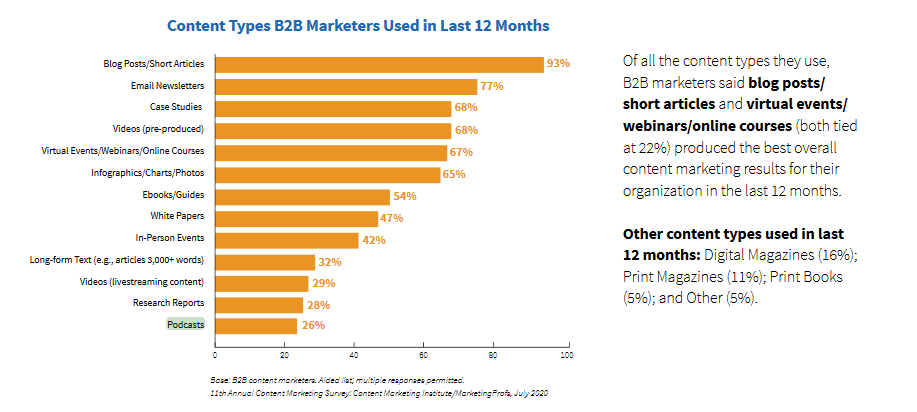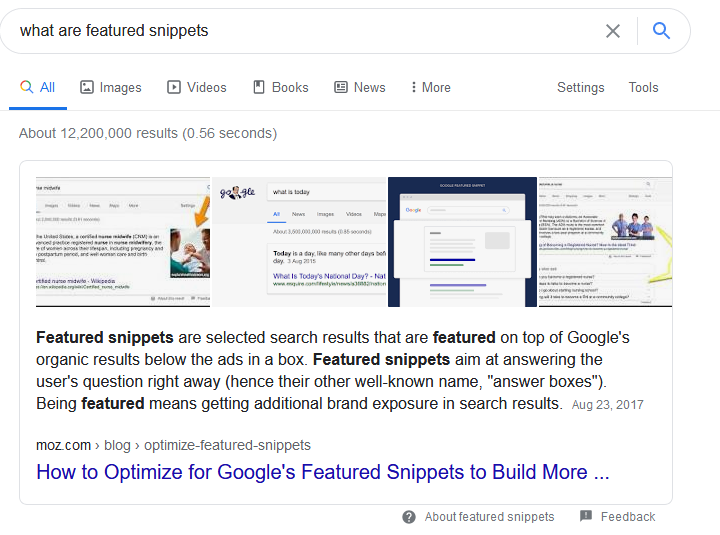The only thing constant in 2020 was change!
From politics to business, we saw changes happening at breakneck speeds. For companies all across the board, it was all about how quickly they can adapt to the changes. In the coming year, the adaptability will prove to be just as much a game changer as before.
To get B2B content marketers on the right track in 2021, we’ve developed a list of the top six trends B2B marketers can follow in 2021.
So, follow along and let’s begin.
Trend #1: Podcasts

For a while now, long-form, informative content has been a major aspect of B2B marketing. Now, that format is taking a twist for the better. Instead of writing long-form content, we now have podcasts: highly engaging and conversational in nature.
If you have a voice and are an expert in the subject matter, then podcasting is a concept you should get around with immediately.
The Content Marketing Institute (CMI) reports that in the last 12 months, podcasts were used by 26% of B2B marketers. While that might seem an insignificant percentage compared to blog posts and articles, you also have marketers utilizing videos and live streaming content to their advantage.
Combine the two statistics together, and you have a healthy percentage of audio-visual B2B content.

So, how can you get started with podcasts? Let’s make one thing clear: you don’t need to have a big budget setup to start up a podcast. If you have something to say, then all you have to do is get on the mic and start talking. Production value holds less precedence when you have good content.
The only good investment you can make is a podcasting mic. Once you’ve done that, you’re good to go. What about editing? Depending on how well you speak, there are only a few edits that you have to make.
All of this combined makes the podcasting process a lot less time consuming and cost effective.
Now, you can host the podcast on your own website if that’s a possibility. If you don’t have an established reader base, then you can publish it on a podcast network like Spotify or even YouTube.
As discussed above, you can combine video conferences and webinars with podcasting. A Zoom meeting is a video, a sales call could be a webinar, and a conversation, online or offline, is a podcast.
You can try any one of these and implement them, there is really no limit to the lengths that you can go to. It’s a marketing trend that’s bound to get traction in the coming years.
Trend#2: Marketing Partnerships

When starting up a new B2B marketing campaign, most businesses tend to focus on marketing activities and personal branding. While there is no problem with that per se, in the modern landscape, that’s not an effective method of conducting business.
There’s so much you’re missing out on while staying within your business’ silo.
Nowadays, businesses that isolate themselves from similar businesses and the industry as a whole are on their way out. In order to get your feet off the ground, you need to establish alliances and partnerships within the industry.
From maintaining a healthy relationship with your suppliers and business partners, to ensuring team cohesion with each other’s marketing departments, there are a lot of different things you can do in order to maintain team cohesion.
This is a highly effective method to expand your business networks. It creates a professional persona for your business that makes other businesses more comfortable in doing business with you.
It’s a win-win partnership that helps establish a good relationship between businesses and opens the door for better business opportunities.
Trend#3: Personalized Email Marketing

Even since the web got personalized, e-mail marketing has been used to provide useful information and relevant offers to users across the board.
It’s not a new concept. It’s one of the marketing tactics that’s aged like fine wine. But while it’s a useful tool, automation within those processes have rendered emails largely ignored and sent to junk.
Automation is useful, but seeing as how it’s not reaping any particular results, it’s time we embrace tradition and revisit personalized email marketing.
Personalized emails? We know what you’re thinking. If you’re a B2B marketer with a large email list, then catering to each user with a personalized email can seem a tedious task.
In this context personalized email marketing is something different. It’s a list of carefully curated emails that address each person on an individual basis while being for the general audience. Whenever the user opens those emails, the email doesn’t feel “robotic” but human.
To get started, place an emphasis on email outreach and the pitch. This is where you grab the attention of the reader. The entire gist of your B2B content goes there, and you have to make sure you nail each and every word of the copy.
The ideal goal with a personalized email is to target each potential lead based on their business processes rather than just pitching them your products or services. Users who open up these emails will be more inclined to read an offering tailored to them rather than a robotic pitch.
Now, you only have to personalize the first email. For the follow ups, you can use a generic email template. The emphasis on the initial email was to ensure that you create a healthy first impression.
Trend#4: Featured Snippets
Have you ever typed a search query on Google and a small box opens that directly answers your query? If you’ve seen that, then it means you have seen featured snippets.
The box is made to facilitate the user-experience by providing the most relevant search result on the page. Google doesn’t make these on its own but instead relies on marketers and content producers who answer these questions within their major content pieces.
For 2021, you need to capitalize on featured snippets.

In order to get your content up on the featured snippets tab, you need to target common search terms used in the industry.
When optimized correctly, a featured snippet allows you to drive engagement with your content and provides your business relevancy and authority.
The only prerequisite to ace featured snippets is a good writing team and an even effective marketing team.
Trend #5: Video Content

We’re going to reiterate the point we talked about in the podcast section but with a little twist.
Video content now converts more than written content. Video content marketing for B2B, therefore, is here to stay.
Think of it from the users’ perspective. Instead of reading content, they are able to see a boiled-down version of your products/services in a 2-3-minute video. Convenience is the thing that matters.
You need to make your offering worth the customers’ time.
Similar to podcasts, you don’t need to invest in quality that much. The written word for the video (aka the script) is one that needs to capture a users’ attention. There are plenty of tools you can use to make the video creation process a lot simpler.
You don’t need a high-end explainer video. With the right tools at your disposal, you can add ingenuity yourself if you have the right content.
You can post those videos on your Instagram, Facebook, Twitter, and yes, TikTok and Snapchat handles as well.
Trend #6: Topical authority

In the old days, content creation was centered around keywords. If you integrate the right keywords within your content, Google and other search engines will index you higher.
While the days of keyword stuffing are long-gone, proper keyword integration is also on its way out. What you need now is solid, well-informed content that’s aimed towards the user rather than keywords.
This brings us to topical authority. Within your content, you should focus on building authority over a subject matter rather than just writing content. This involves creating content that’s informative and aims at solving user queries.
Trend #7: Focus on Search Intent

The concept of search intent is based on the terms users want to search on Google. For B2B content marketing in 2021, you need to focus on search intent rather than keyword searches. You need to match your content with what people are searching online.
To increase reliability within searches, Google wants to show the most relevant results to users without them having to click every time. To make sure you’re following up on Google’s requirements, you would need to alter your content for relevancy.
You can create listicles, how-to articles, and create summaries of your content pieces at the very top of your page. This helps you gain a better ranking for your content than your competitors.
Conclusion:
In this post, we discussed the six B2B content marketing trends for 2021. With these trends in mind, you can get started on the right track and power up your B2B content marketing campaigns for the new year.
We hope you enjoyed reading!
